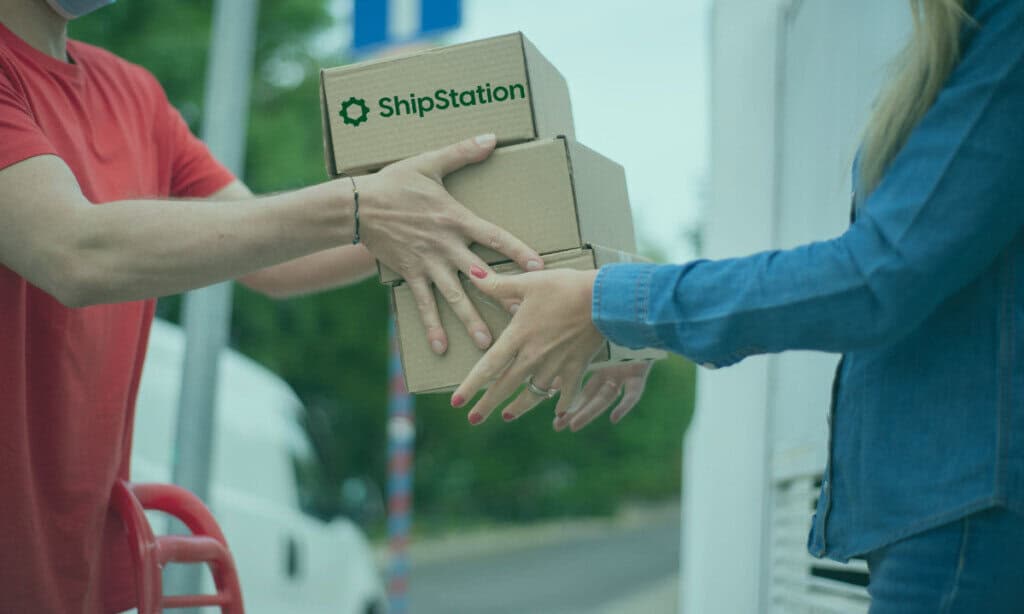- Top ShipStation Alternatives at a Glance
- Why Look for ShipStation Alternatives?
- The Top ShipStation Alternatives for eCommerce Store Owners
- Shippo: Fantastic All Around Player
- ShippingEasy: Blending Fulfillment and Customer Engagement
- Easyship: For Stores With Serious Global Ambitions
- AfterShip: Taking the Post-Purchase Experience Seriously
- ShipHero: Warehouse Management for Complex Operations
- Stamps.com: Straightforward Shipping for Small-Scale Sellers
- Choosing the Right Shipping Platform for Your Online Store
- Final Thoughts: Why Shippo Stands Out
Last Updated on July 30, 2025 by Ewen Finser
Not too long ago, shipping was something of an afterthought. A part of the process you only considered after making the sale. But in a world where Amazon has conditioned customers to expect same-day delivery in some instances, shipping is now a competitive advantage.
I could argue that delivery times can influence if a customer orders from you again or doesn’t. And the customer doesn’t care if you run your business from your kitchen table or you manage a 100,000 square feet fulfillment center
One platform every ecommerce business usually runs to is ShipStation. But that doesn’t automatically make it the best fit for everyone. Sure, it has a great feature set, such as centralized order management and discounted rates with a bunch of carriers. However, if you’re a small to mid-sized store, it can be an overkill.
And then there’s the pricing. ShipStation has raised its rates multiple times, leaving many users frustrated and looking for something more affordable, consistent, or simply easier to use. The good thing is there are several top ShipStation alternatives that tick those boxes and can also scale up with you as your store grows.
Let’s get into it.
Top ShipStation Alternatives at a Glance
- Best Overall: Shippo
- Best for Marketing Integration: ShippingEasy
- Best for International Shipping: Easyship
- Best for Post-Purchase Experience: AfterShip
- Best for Warehouse Operations: ShipHero
- Best for Small Sellers: Stamps.com
Why Look for ShipStation Alternatives?
ShipStation’s strengths are clear: expansive carrier integrations, high-volume label generation, and time-saving automation tools. It also provides access to heavily discounted rates from UPS, USPS, FedEx, DHL, and more carriers, which is essential for smaller vendors that don’t have direct carrier contracts.
If you’ve noticed your ShipStation bill creeping up lately, you’re not alone. The platform has raised its prices multiple times over the past few years, and for many users, the increases haven’t felt entirely transparent. ShipStation uses a tiered pricing model that now starts at $14.99/month for up to 50 shipments, but if your volume grows even a little, you’ll quickly find yourself in a higher (and more expensive) tier.
The more you scale, the more some of its limitations show. Want to use your own carrier account? You need to pay extra fees. Want some nifty Zapier integrations? Well, you need to pay more. Suddenly, the “affordable” shipping software doesn’t feel so affordable.
Plus, the way ShipStation handled the recent price hikes left a lot of small business owners wondering if it’s still worth it. These recent Reddit threads are a good look into how people feel about the monthly fee increases:
The Top ShipStation Alternatives for eCommerce Store Owners
Shippo: Fantastic All Around Player
When balancing cost, features, ease of use, and integration to selling platforms such as Shopify, eBay, Amazon, Woocommerce, and Magneto, Shippo hits the sweet spot. It doesn’t try to be everything to everyone, but rather focuses on simplifying shipping, delivering excellent value, and making smart use of automation.
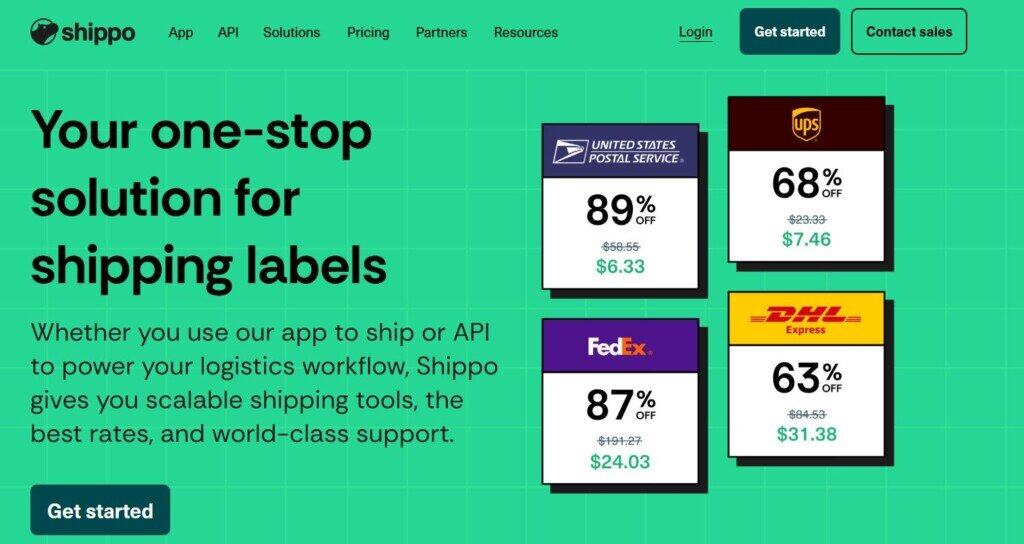
What I Like
For starters, Shippo gives you access to more than 40 global carriers, with discounts of up to 90% off retail shipping rates for USPS, UPS, and DHL. More importantly, it allows paid users to connect their own carrier accounts at no extra cost, a significant plus for businesses that negotiate directly with shipping providers. This puts pricing control back in the hands of the vendor.
Which brings me to a big plus: pricing transparency.
While Shipstation has repeatedly raised their prices and started to charge steep (and confusing) surcharges, especially for features that were once included, Shippo keeps things consistent.
Shippo also gets points for ease of use. The interface is clean and intuitive, syncing orders is effortless, and purchasing labels, whether one-off or in bulk, is fast and glitch free. Automation features let you set rules for selecting carriers, printing labels, or validating addresses, minimizing the manual tasks that eat up hours during busy seasons.
International shipping is another standout strength. Shippo generates customs documentation, offers international address validation, and simplifies the complex logistics of global shipping. Whether you’re sending packages across town or across continents, Shippo makes sure compliance doesn’t become a bottleneck.
Returns, a critical piece of the post-purchase experience, are also smoothly managed. You can generate return labels, sync return tracking and create branded tracking pages that reinforce your store’s identity. These aren’t flashy add-ons, but thoughtful features that enhance your customer service and reduce support tickets.
What I Don’t Like
If there’s one downside to note, it’s that Shippo’s support, while responsive, occasionally receives mixed feedback from users, especially when dealing with billing or label download issues. These are not widespread problems but worth mentioning for stores with more sensitive logistics needs.
If you are a really advanced user, ship thousands of orders per month, and therefore need a lot of features and integrations, you may want to try Shipstation. If you want simplicity and transparency, go with Shippo.
Pricing
Shippo’s pricing structure is especially appealing for smaller vendors and those testing the waters. The free plan supports up to 30 labels per month, with access to discounted rates and basic automation. It’s ideal for newer stores, but for those ready to scale, the Pro Plan starts at $17/month and includes free integration of your carrier accounts, branded tracking tools, and support for up to five users, which makes it worth it, in my opinion. Enterprise level plans are custom priced, and scale affordably based on volume.
Who I Think Shippo Works Best For
Overall, Shippo is an excellent choice for vendors who want great rates, automation, and seamless integration without feeling locked into a high-cost structure.
ShippingEasy: Blending Fulfillment and Customer Engagement
ShippingEasy is another interesting option. It offers many of the core shipping functions ecommerce vendors need: rate comparison, label printing, and batch processing, but adds a twist by integrating email marketing and customer communication into the platform.

What I Like
For small businesses, this integration means you don’t need separate tools for shipping and post-purchase engagement. ShippingEasy lets you send abandoned cart emails, feedback requests, and promotional messages directly from your order dashboard. If you’re looking to turn shipping into a marketing opportunity, this integration is highly attractive.
On the shipping side, ShippingEasy supports automation rules that make processing large volumes easier. You can assign carriers based on destination, weight, or cost, and print labels in batches to save time. Their USPS discounts are especially strong, and the platform leverages exclusive cubic pricing that can make a huge difference on small, heavy packages.
ShippingEasy also offers native integrations that make setting up your sales channels pretty painless. Orders flow in smoothly, and for most small to mid-sized shops, the built-in inventory management feature does the job. You also get helpful touches like branded tracking pages, email notifications, and streamlined return tools that round out the core features nicely.
What I Don’t Like
ShippingEasy generally gets high marks for being beginner-friendly, but it’s not without its hiccups. Some users have run into issues when it comes to more complex billing questions or technical support, especially when those problems aren’t easy to explain or fix quickly. There have also been occasional reports of surprise charges or rate changes that weren’t clearly communicated, which can be frustrating when you’re trying to keep costs predictable. And while the interface is mostly smooth, small quirks like finicky CSV uploads or limited mobile features can sometimes slow you down during crunch time.
Pricing
Pricing starts with a free plan for up to 25 shipments per month. Paid plans begin at $19.99/month and scale based on shipment volume, unlocking additional features like branded communication, analytics, and support for multiple stores.
Who I Think ShippingEasy Works Best For
What distinguishes ShippingEasy is its consistently high marks for customer service. Users regularly note its fast, friendly, and solution-oriented support team. For vendors who want more out of their post-purchase customer experience and want to integrate shipping and CRM into a single dashboard, ShippingEasy is worth serious consideration.
Easyship: For Stores With Serious Global Ambitions
Easyship positions itself as the go-to solution for online sellers dealing with international logistics. Its standout feature is transparency: it shows total costs including duties, taxes, and shipping fees right at checkout. For vendors, this reduces refund requests and customer complaints. For customers, it creates a frictionless buying experience that builds trust.
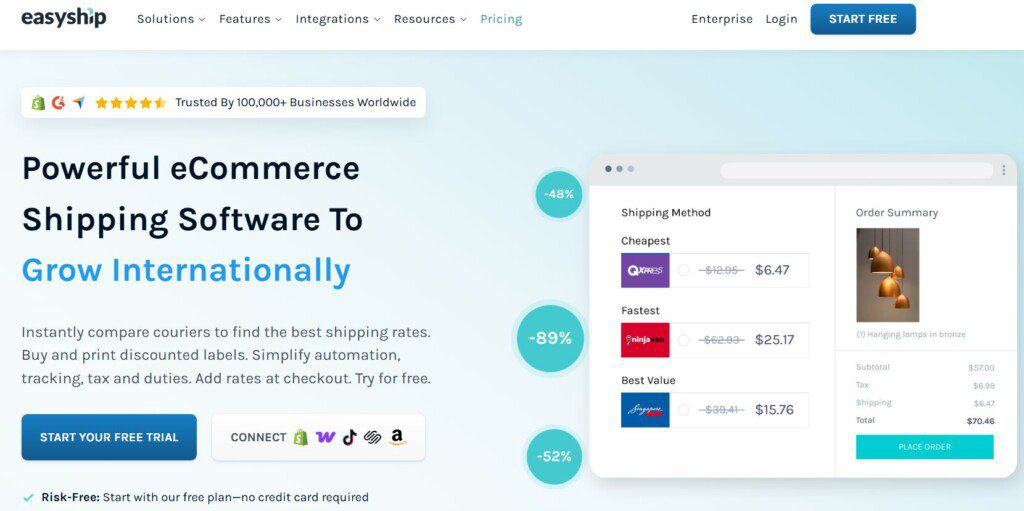
What I Like
The platform connects with over 550 couriers and provides access to more than 250 shipping options based on destination, budget and delivery speed. Easyship also helps you pick the best carrier using smart automation based on your own business logic. You can also automate shipping rules by geography, product type, or customer profile.
Part of the founders broader vision is to make global shipping as simple as domestic. And you see that with how the platform automates forms, calculates import duties, and even lets you select fulfillment centers closer to your international customers to reduce delivery times. Plus customs support is top-notch.
Integration is smooth, orders import instantly, and fulfillment happens within a few clicks. Easyship’s interface is modern and intuitive, which helps reduce learning curves when onboarding a new team member.
What I Don’t Like
Its sophisticated global shipping features for global shipping mean Easyship can present a steep learning curve for new users. Another concern that keeps popping up among users is the often-challenging process of filing insurance claims, which can be lengthy and frustrating. The biggest frustration here is that denials are sometimes attributed to minor technicalities. This combination of initial complexity and post-shipping claim difficulties can diminish the overall user experience for some vendors.
Pricing
Pricing is competitive. There’s a free plan with limited access, while professional plans begin at $29/month and include a 14-day trial. These tiers offer advanced automation, reporting, and branding capabilities.
Who I Think Easyship Works Best For
Easyship is best suited for online vendors with a substantial international business or those looking to expand globally. If most of your orders are domestic, other platforms may offer a better fit. But when your reach is cross-border, Easyship turns complex logistics into manageable workflows.
AfterShip: Taking the Post-Purchase Experience Seriously
AfterShip flips traditional ecommerce shipping on its head. Instead of starting with label generation or carrier selection, it starts with what happens after a package ships, making sure customers know where their order is, when it’ll arrive, and how to return it if necessary.
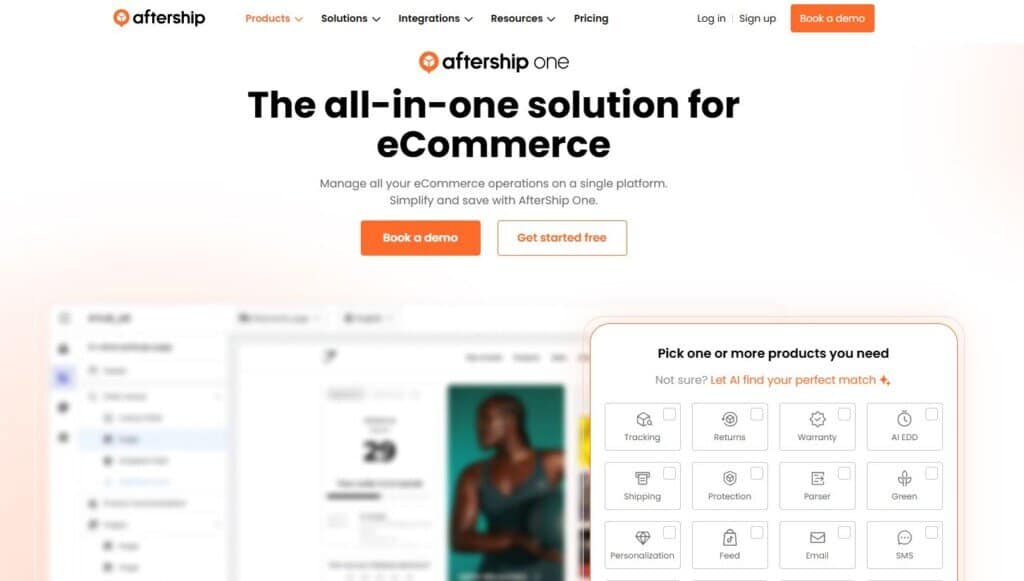
What I Like
AfterShip stands out when it comes to tracking. You can create branded tracking pages, send SMS and email notifications at each delivery milestone, and provide predictive delivery windows using its built-in AI. These tools help reduce support tickets and boost customer confidence.
Returns are just as thoughtfully handled. The customizable returns portal allows customers to initiate and monitor their return with minimal friction. For stores with high return volumes, this improves customer experience and reduces backend complexity.
On top of that, AfterShip includes some nice marketing extras like personalized emails, customer segmentation, and review requests. It’s not a full-fledged email marketing platform, but it’s plenty for managing targeted post-delivery communications.
What I Don’t Like
While AfterShip offers a lot of value when it comes to post-purchase engagement, the costs can add up fast as your shipment volume grows. Pricing jumps quickly between tiers, and support for certain carriers is sometimes tucked behind higher-priced plans, which can catch some users off guard.
The setup process can also feel a bit overwhelming at first. Some folks find the admin panel tricky to navigate, especially when trying to adjust billing or locate specific settings. So, while AfterShip is a powerful tool, the combination of rising costs and a steeper learning curve might make it a tough fit for businesses with limited budgets or teams without much tech experience.
Pricing
Entry plans begin at $9/month for up to 1,200 shipments per year. Larger stores can opt for Premium or Enterprise plans, which scale based on shipment volume and unlock advanced support, integrations, and analytics.
Who I Think AfterShip Works Best For
If your brand depends on keeping customers informed and engaged after a purchase, AfterShip is a good solution, even if you continue using other software for label generation.
ShipHero: Warehouse Management for Complex Operations
ShipHero stands apart as a warehouse management system (WMS), ideal for vendors whose fulfillment operations extend beyond label printing and simple inventory sync. For brands running multi-warehouse setups, managing detailed product logs, and handling tens of thousands of orders, ShipHero provides the infrastructure necessary to maintain efficiency and scale without compromising on accuracy.
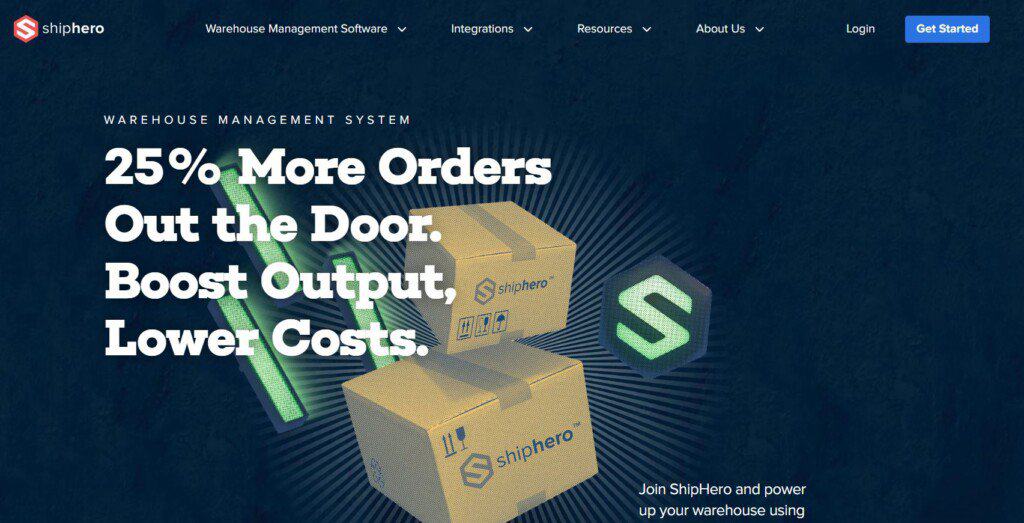
What I Like
Its WMS tools offer deep control over inventory, enabling vendors to track real-time stock levels across locations, create advanced replenishment rules, manage purchase orders, and perform cycle counting. If you sell bundled products, use kits, or frequently move inventory between sites, these features are a must-have.
ShipHero also empowers pick-and-pack teams with mobile optimization. Its iOS app allows staff to scan barcodes, follow optimized picking routes, and reduce errors with real-time feedback. This feature reduces fulfillment mishaps that can drive up costs.
On the shipping side, ShipHero supports multi-carrier rate shopping and label generation, with automation rules that assign shipping methods based on order details. Integration with platforms is simple and stable, and vendors can monitor orders, returns, and customer communication through a centralized interface.
What I Don’t Like: Pricing
ShipHero’s sophistication comes with a price. Entry-level software plans start at $499/month for up to 1,000 orders, and fulfillment pricing is custom-quoted, often placing it out of reach for smaller operations.
While the software earns high marks for reliability and support, outsourced fulfillment services have received mixed reviews, particularly around pricing transparency and service consistency.
Who I Think ShipHero Works Best For
For sellers who manage their own warehouses and crave an enterprise-grade logistics suite, ShipHero delivers robust features and operational clarity. But if your business is still growing or relies on third-party logistics providers, the investment may outweigh the return.
Stamps.com: Straightforward Shipping for Small-Scale Sellers
Stamps.com is one of the more traditional options on the list, and for good reason. It’s geared toward vendors who need simple USPS and UPS postage solutions without advanced features. While it doesn’t offer the automation, branding, or multi-carrier flexibility you’ll find in these other platforms, it excels at its primary purpose of generating labels quickly and easily.
It connects to major e-commerce sources, enabling users to import orders and print shipping labels from a central dashboard. International shipping features include customs form auto-fill and basic tracking visibility, but don’t expect the nuanced tools seen in platforms like Shippo or Easyship.

What I Like
This is your basic, no-fuss solution. There’s no advanced features, and no high price tag. If your shipping needs are light and you’re looking for straightforward execution, Stamps.com is a reliable option.
What I Don’t Like
Stamps.com faces widespread criticism for its billing practices, with numerous reports of users being unknowingly charged recurring monthly fees after trial periods and significant difficulties in canceling subscriptions. Customer service is frequently cited as unhelpful and unresponsive, particularly when addressing these billing disputes or requests for account closure. This combination often leaves users feeling frustrated and financially impacted, overshadowing any benefits of its postage services. So, don’t skip reading their TOS.
Who I Think Stamps.com Works Best For
Stamps.com is best suited for vendors operating at low volume who don’t require complex rules or post-purchase engagement tools. It’s also a reliable fallback for sellers who prioritize USPS or UPS and want minimal setup or technical involvement.
Choosing the Right Shipping Platform for Your Online Store
Choosing the right shipping software isn’t just about ticking off a features list. You need a tool that fits how you run your business today and how you want to run it tomorrow.
If your business is just starting out, the ideal platform will help you reduce costs without sacrificing reliability. If you’re scaling quickly, you need tools that automate complexity and prevent bottlenecks. If you’re expanding internationally, customs and total cost transparency are essential. And if your brand relies on delivering a high-quality post-purchase experience, tracking and returns need to be part of the equation and not an afterthought.
It’s also worth evaluating support quality. A powerful feature set means very little if you can’t get help when something breaks. Response time, escalation policies, and user reviews provide essential clues to whether a platform’s support team will be a true partner or just another inbox to chase.
Interface usability matters, too. Whether you’re training new staff or managing fulfillment yourself, clean workflows and intuitive dashboards reduce operational friction and free up your time for higher-impact decisions.
Lastly, scalability. Switching platforms mid-growth is costly and disruptive. The best option isn’t necessarily the one with the most features right now, but the one that can grow alongside your store without forcing a full migration six months from now.
Final Thoughts: Why Shippo Stands Out
Each of the platforms discussed here offers powerful tools and clear value for vendors depending on their goals:
- ShippingEasy excels at combining shipping with marketing touchpoints.
- Easyship shines for vendors targeting international audiences.
- AfterShip leads in post-purchase communication and tracking visibility.
- ShipHero dominates for warehouse-heavy operations and enterprise-grade logistics.
- Stamps.com delivers simplicity for light-volume sellers.
But when it comes to the best overall alternative to ShipStation, Shippo consistently hits the mark.
It offers a generous free tier, powerful automation, deep carrier discounts, and clear, scalable pricing, all wrapped in an interface that’s easy to navigate and a system that integrates flawlessly with e-commerce platforms like Shopify, eBay, and Amazon.
For store owners ready to simplify their fulfillment, improve customer satisfaction, and save money on shipping, Shippo is the smart balance between functionality and affordability.

